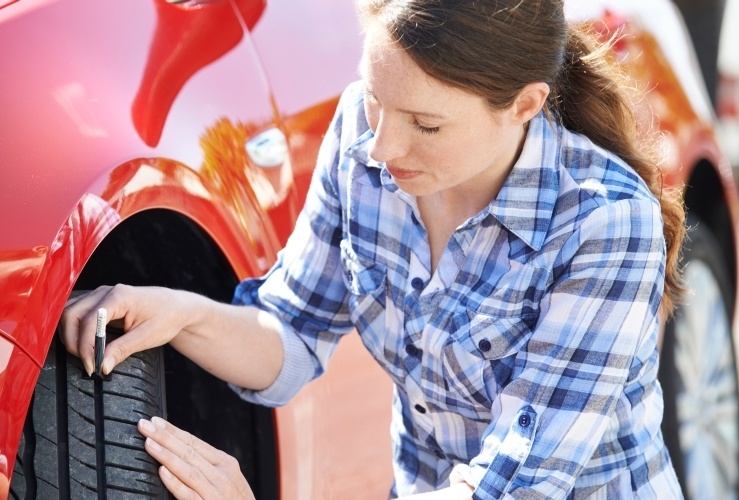
Every year, thousands of cars break down on the UK's roads, causing havoc for those in and outside of the vehicle.
Having your car give up on a journey can be stressful, put drivers and passengers in a bad mood - and even spoil a long-awaited holiday.
The key to avoiding finding yourself in one of these situations is to get your car serviced to the manufacturer's schedule or specification, as this will stop something minor becoming a major problem further down the line.
However, you can reduce the risk of a breakdown yourself as well, by performing simple car maintenance checks that will help you enjoy a stress-free journey.
Here are eight areas of your car that you should give a once-over, to help stop your vehicle from breaking down out unexpectedly.
1. Check your tyres
Tyre pressure
You should consult your car's handbook to make yourself aware of the correct tyre pressure for your motor, which should be checked at least every two weeks using a high-quality gauge or garage air line.
Tyre tread
The tyre tread and overall condition should be inspected, paying particular attention to any cuts on the sides walls.
Could you have a slow puncture?
If you're finding yourself putting air into one tyre often, it could have a slow puncture, meaning it will need to be changed.
Our handy guide explains what you should do if you get a flat tyre.
Top tip: Don't forget to check the spare as well, as this could help you get back on the road in no time at all.
2. Make sure your toolkit is complete
Your car should also be equipped with a toolbox and your handbook will tell you where it is located. Inside should be a jack and wheel removal tools, at the very least.
Familiarise yourself with the jacking points that you can use to safely lift the car when changing a tyre.
If your car is fitted with locking wheel nuts, make sure the toolkit includes the key or removal tool.
Top tip: Wanting a more comprehensive kit? Read our guide about what any tool box should contain.
3. Oil - levels and changing
This is another thing that needs to be checked on a regularly basis, with the dipstick needing to be inspected at least every fortnight.
In addition, the oil and filter should be changed at the recommended service intervals, using the correct specification of oil, as using the wrong type can cause all sorts of problems.
Read our guide to find out what type of oil to use in your car and how to check your oil level.
Top tip: If your car is consuming a lot of oil, this could be indicative of a larger issue with your engine. Get your motor checked out at your garage if this happens.
4. Top up water levels
You should check the coolant level in your car frequently and top up whenever it is necessary - but be sure to do this only when the engine is cold, as you could burn yourself if it is still hot.
Antifreeze
Before the winter months descend, check the antifreeze concentration in your car, as this liquid helps prevent the build-up of corrosion within the cooling system.
Top tip: Antifreeze also stops the coolant in your engine freezing, meaning it's important to keep the level topped up all year round.
5. Windscreen wiper health check
Over time, windscreen wiper blades degrade, which causes them to become less effective at clearing your line of sight. This can be a big problem when driving through a downpour, blizzard or if something drops onto the windscreen and needs to be washed away.
Windscreen wiper blades should be replaced at least once a year, to ensure they are in peak condition at all times.
Top tip: When your wipers begin to leave streaks across the windscreen or leave big patches of water untouched, it's time to change them.
6. Ensure you have enough screenwash
This should also be checked regularly and topped up, particularly as it is a legal requirement for the system to work.
Rather than being attracted to a lower-priced brand, always use a good-quality screenwash in both winter and summer, as using water alone is unlikely to shift oily road grime and is prone to freezing in the colder months.
Top tip: Don't use washing up liquid to clean your windscreen, as the salt it contains can damage your car's paintwork.
7. Inspect the windscreen
You must also check the windscreen itself, as any damage could distract your attention while driving.
Top tip: Always get small chips repaired, as they can quickly become large cracks that see your whole windscreen needing to be replaced.
8. Test all lights
All lights - including indicators, brakes and fog - should be inspected and cleaned on a weekly basis.
If you're driving through bad weather, wipe them with a damp cloth when you stop for breaks.
Top tip: Make sure that your headlights are aimed properly, as if they aren't, you could blind other drivers or reduce your ability to see the road.
Carrying out these car maintenance checks can help to reduce the risk of your vehicle breaking down.
But are you covered should a breakdown happen?
Get a quote online today for breakdown cover from Start Rescue to ensure help is at hand should you breakdown.
What should you do if you do break down?
Our handy car breakdown tips provide 8 essential roadside recovery tips for dealing with a breakdown.




